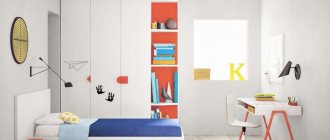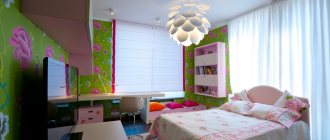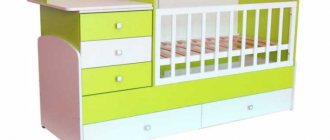Finishing and painting walls in a nursery is an important and responsible moment, since not all materials are suitable for children. Painting is the fastest and easiest way to cover: having prepared the walls for it once, you can only refresh or change their color in the future.
Painted walls are an inexpensive solution that has a huge number of design options, limited only by your imagination
Pros and cons of painting walls in a children's room
Coatings made from modern paints are practical, reliable, safe and easy to clean. Painted walls are not afraid of felt-tip pens and handprints; all traces can either be washed off or repainted. Painted walls in one color will be the best background for all kinds of decoration. If desired, they can be decorated with vinyl stickers or painted with acrylic paints.
The paint allows you to decorate the walls to your taste, you just need to come up with a plot and choose the right color
The easiest and most ideal option for selecting materials for painting walls in a children's room is to find paint labeled “for children” or “kids”. The paint used for a child's room should be water-based, non-toxic, and environmentally certified.
It is strictly not recommended to paint children's walls with oil or alkyd enamel paints, since they contain harmful substances, they form a film on the surface of the walls that does not allow the walls to breathe, and also have a sharp and unpleasant odor, which very often causes allergic reactions.
Wall painting is often combined with other finishing materials, creating an original and unique interior.
What wall color should I choose for a children's room?
The emotional state of a child is directly influenced by the surrounding space, and the color scheme is no exception. What color should I choose for the nursery? Here it is worth taking into account the age, character and wishes of the child. Designers highlight several ideas that will help you choose the most suitable shade of paint for the walls:
- Consider the child's age. It is advisable to paint the walls of a children's room for newborns in neutral and pastel shades; this color scheme will help the baby fall asleep faster. For preschoolers, more saturated shades are most often chosen: orange, blue, blue, yellow, green. The school process requires concentration, so walls in calm, cool shades are suitable for school-age children. The walls in a teenager’s room can be painted in any color he likes: “neutral adult” or a rich shade.
- Consider how a particular shade affects the child’s activity and mood. Pale yellow wall color in a children's room is an excellent choice; it improves mood and acts as a tonic. When buying paint, be guided by the character and temperament of the child. For active children, it is better to choose more neutral, warm shades: beige, blue, pink, lilac, gray, white, lilac. For quiet, shy children, on the contrary, a more saturated range is suitable: orange, red, blue, yellow, bright green, purple, crimson.
- Consider the direction of the light rays and the degree of illumination of the room. For rooms located on the south or west side, a cooler color design is suitable: taupe, blue, blue, ash, purple. If the children's room is located on the north side, then light shades are suitable for decorating the walls: beige, cream, pink, light green and blue. The universal colors are white, brown, green and gray.
There are additional tips on how to paint walls in a nursery:
- Many people are interested in painting the walls in a children’s room “for growth.” In such cases, it is worth using paint of a neutral shade - it can be gray, beige, brown, graphite or light green. Be sure to consult with your child before painting. It’s good if he chooses the color of his room himself. Offer your child several neutral colors to choose from and let him choose the one he likes.
- Before painting a children's room, it is worth thinking about such aspects as zoning or visually increasing the space. If the room is very small, give preference to light colors, they will add light and more air, and visually the room will become more spacious. To zone a large room, on the contrary, you should use dark, muted tones.
- If your child is a “little one”, do not use blue shades to paint the walls. Doctors have proven that blue and cyan colors reduce appetite. If your child does not eat much, it is better to give preference to bright, saturated colors, in particular yellow and orange (they increase appetite). In addition, the color orange, for example, evokes a sense of responsibility, promotes child independence, increases self-esteem and improves imagination.
On video: what colors to choose for the nursery.
Selection of materials for painting
Paint for covering walls in a children's room should have the following characteristics: hypoallergenic;
- moisture resistance;
- breathability;
- resistance to external influences and mechanical damage.
The following types meet all of the above requirements:
- acrylic;
- water-dispersion or simply water-based emulsion;
- silicone;
- latex;
- environmental paints.
Paints and varnishes without toxic components are suitable for painting the walls of a children's room.
- Acrylic paints dry quickly, have virtually no odor, form a highly durable matte surface when dry, and are easy to clean.
- Water-dispersed ones are odorless, dry very quickly, are breathable, easy to clean and inexpensive.
- Silicone paint is a very durable, modern material designed for painting walls. It is both waterproof and vapor permeable, which is why it is often used for bathrooms.
- Latex. This paint fits well on walls and holds tightly. The painted surface is very pleasant to the touch.
- Ecological paints feature exclusively natural ingredients. The name itself indicates suitability for finishing children's rooms. The only disadvantage of such paints is their high cost.
Special types of paints
Separately, we can highlight paints that make it possible to obtain coatings with unusual properties.
- Chalkboard paints provide a coating on which to paint. The texture of the surface allows not only to apply drawings on it with various materials, but also to remove “art” if necessary.
Slate paints allow you to combine business with pleasure
- Teflon paints do not interact with most substances and repel dust and debris. Such coatings will remain clean for a long time.
- Antibacterial – compounds that have an antiseptic effect. The presence of silver particles in their composition allows them to destroy harmful microorganisms.
- Anti-condensation paint – has low thermal conductivity, which allows the room to better retain heat.
Choosing a color palette
When choosing a color, it is important to pay attention to the size of the room, the height of the ceilings and the degree of illumination.
For a small room or with windows facing north, it is better to choose light colors
Cool shades look harmonious in sunny rooms. Northern bedrooms are best decorated in warm and light colors. To expand the space, you need to use light shades. If the room is not only small, but also dark, the ideal option is white walls.
White walls will visually increase the space of a small room
In a newborn's bedroom, pastel colors and calm shades are appropriate: cream, pale green, powder pink, pale blue, light lilac. Delicate shades will help your baby sleep peacefully.
The right shades and decorations will create a favorable atmosphere in the baby's room
For children from 2 to 5 years old, you can choose more saturated colors: green, orange, yellow, blue, pink and even red.
Little homeowners will be happy to take part in decorating the walls of their room.
For school-age children, calm shades of green, blue, turquoise or light blue will help them concentrate. The walls of a teenage room can be decorated in light gray, olive, gray-blue, beige, brown. You can also choose bold and bright shades. For a girl's room, use black and white walls with a pink accent, and for a boy, use orange.
A teenager’s room is a place for self-expression, the design of which should be chosen by the owners of the room themselves
What color to paint a children's room photo
Most often, the color of the walls in the nursery is selected depending on the gender of the baby, but this is not always correct. There are many theories about the influence of color on the mental, emotional and physical state of a child. Therefore, the selection of a color palette should be individual.
Using paint of different colors, you can paint your favorite garden on the wall of the room with your own hands.
Red hues are considered very intense - they can increase blood pressure, cause rapid breathing and heart rate, and also stimulate brain function. These colors will not harm lethargic and inactive children. While for hyperactive children they are contraindicated, as they can cause nervous overload.
It's very easy to decorate a room with simple designs using stencils
Shades of yellow are suitable for preschoolers. In a sunny room, the child will concentrate better. Orange will bring a feeling of joy and warmth. Blue shades will relieve anxiety and worries, and also increase interest in receiving new information. Green tones will ensure a restful sleep and a great mood. With the help of pink shades it is good to accustom your baby to coziness and comfort.
The color yellow is associated with the sun, warmth and summer holidays
Light gray walls will serve as an excellent backdrop for bright decor.
Exquisite lilac shade makes the atmosphere very cozy and attractive
It is very important to think through and choose the right tandem of colors for decorating the nursery’s interior. So that the child does not feel depressed, is less tired and is in a good mood, the primary colors should not be too bright and saturated.
A children's room can become a space for joint creativity between a child and parents. There are many options for designing walls in a nursery: you can paint them in different colors, apply a pattern or ornament to the painted surface, or make the wall velvety using special paints. A graphite wall looks very original, which a child can paint on his own with chalk.
A slate wall is an excellent solution for preschool children
Painting your walls the same color may seem like a boring idea, but it is very practical. Children grow quickly, so decorating plain walls with special stickers will help transform, and, if necessary, change the plain space of the children's room. This option will help save money, while quite easily allowing you to reload the space in the children's room.
A wall in the nursery that children can decorate themselves with stickers or drawings
Teenagers' interests, habits and priorities change. Toys on the shelves are replaced by books and school supplies. The design of the room becomes aimed at creating a favorable environment for study and creativity. Some teenagers need a bright interior to keep themselves in good shape, while others need a calm palette for studying and relaxing after class.
Painting walls with white paint in a minimalist style room
Children's room in high-tech style with plain light gray walls
Combination of gray surfaces with brickwork in a loft-style room
If the room has a small area, then it is better to make it in light colors, and to add brightness, decorate the accent wall in rich and bright shades; the child can paint the wall himself with acrylic paints. This way the teenager will be able to show off the unusual environment to his friends.
A combination of two or three colors of the rainbow will dilute the monotonous interior
Safe paint for children's rooms
Paint for walls in a children's room should first of all be safe for your baby's health.
Common household paints can contain up to 10,000 different chemicals, including hundreds of known toxins and carcinogens. And when the paint film dries, harmful volatile organic compounds (VOCs) are released into the air, polluting the environment. They are completely invisible to the eye and can be intangible.
VOCs are harmful chemicals that easily evaporate into the air at room temperature. These include chemicals such as gasoline, benzene and formaldehyde and solvents such as toluene and perchlorethylene (the main solvent used in dry cleaning). They react with sunlight and heat, creating smog that is invisible to the eye.
Although VOC emissions are highest during and immediately after painting, they can continue to emit low levels of toxic emissions for several years.
Quality paint for children's
Pay attention to the quality of paint for the children's room, look for products with low and acceptable levels of volatile chemicals (VOCs). VOCs are often responsible for allergies and upper respiratory tract diseases, not only in children but also in adults.
Children are much more susceptible to harmful substances than adults. This is due to greater absorption of their skin, that is, with easier penetration of active substances into the baby’s body.
To choose paints that are safe for use in children's rooms, pay attention to the presence of certificates indicated on the packaging confirming the correct composition of paint and varnish products: - EU Ecolabel, which is valid in 25 countries of the European Union.
Remember that the paint for a children's room should be hypoallergenic, resistant to damage and dirt, and easy to clean, without losing its original and beautiful appearance.
Flugger paint for children's rooms
The Flugger concern has many years of experience in the production of paints and varnishes (since 1783) and constantly strives to reduce the content of harmful chemicals in its products. This also includes the fairly strict legislation of Scandinavia and Denmark, including where it is constantly required to undergo all kinds of checks and mandatory certification of products and production itself.
Plus, Flugger purposefully undergoes certification, thereby showing the consumer that the products it produces are harmless to people and the environment. Such certificates that mark Flugger products include ECO Label and Nordic Swon.
The company has paints that are recommended for painting children's rooms. They are quite easy to maintain, endowed with increased wear-resistant characteristics and resistance to wet cleaning. Also, all these products are certified on the territory of the Russian Federation, have passed mandatory certification, are included in the state register and are recommended as: for interior decoration of premises, including children's schools and preschools, medical and treatment institutions of Class A, B.
Flugger Products
- Matte, wear-resistant, withstands local cleaning and wet cleaning. More details about the product itself - FLUGGER DEKSO 5
- Silky-matte, withstands local cleaning and wet cleaning (in light colors). About the product itself - FLUGGER FLUTEX 10
Painting walls is the fastest and most practical way to redecorate a room. A new paint color will refresh the look of a child's room and, if done correctly, will delight the child.
Painting walls for a boy
Boys are constantly inventing something, remaking it, rebuilding it. It is the rapid change of shades and shapes that you need to pay attention to. It is better to take calm tones as a basis. For example, you can use different shades of blue or cyan. Plain walls will be perfectly complemented by colorful illustrations, patterns or drawings.
Little boy's room in soft blue tones
Wall decoration theme for a boy:
- fantastic landscapes;
- heroes of famous cartoons and fairy tales;
- space travel;
- technology and its various elements;
- inhabitants of the seas and the underwater world, sailboats, pirates.
An accent wall in a boy’s room can be decorated with photo wallpaper with a world map
Useful and beautiful
Any environmentally friendly interior paint is suitable for decorating walls and ceilings in a child’s room. To make the choice easier, many manufacturers began to produce specialized formulations, the name of which indicates the area of application. In addition, there are unique materials on sale that are suitable for children’s walls. For example, lime paint Ales Shikkui (Kansai Paint), which maintains indoor air quality. Its action is based on the properties of slaked lime - but lime compositions are complex and labor-intensive to work with, while Ales Shikkui is applied like regular paint and retains all the beneficial alkaline properties: neutralizes bacteria and viruses, removes odors, reduces the level of formaldehyde and other harmful impurities in the air.
The specialized paint Ultra Resist Duluh for children (Akzo Nobel) contains silver ions, which prevent the growth of bacteria on the surface. And thanks to the wax, the coating acquires a lotus effect and does not allow water and dirt to be deeply absorbed. The paint layer can withstand the effects of even such aggressive liquids as Coca-Cola, fruit juice, soy sauce, wine, as well as chocolate oil, etc. To return the walls to cleanliness, just wipe them with a damp cloth, and remove more severe dirt with a cloth with detergent means.
Photo: Alpina
Enamel Aqua Buntlack (Alpina) (0.75 l - 990 rub.)
Thanks to the water-borne matte varnish Taika Glow (Tikkurila), painted walls will glow in the dark. With its help, you can “scatter” magic stars on the ceiling of the nursery or place magical luminous signs. The child’s movement along corridors and stairs marked in this way will be safer. The effect is best seen against a light background in a room without lighting. However, in order for the varnished areas to glow in the dark (up to 6 hours), they need to be “charged” under sunlight or artificial light.
Do your children love to draw? Decorate part of the wall in the room with Liitu chalkboard paint (Tikkurila). The surface will become smooth, matte, and you can draw and draw on it with colored crayons, erasing pictures and inscriptions with a damp cloth. As an example, another part of the wall can be decorated with colorful wallpaper.
The rich, cheerful colors that children love so much will be restored to old toys by water-based Aqua Buntlack (Alpina) enamel. The safety of the composition complies with the DIN EN 71-3 standard. The enamel forms a colorful coating that is resistant to saliva and sweat. And toys updated with its help will shine with new colors and will remain shiny, bright and smooth for a long time, without scratches. The main thing is not to give them to children until the paint is completely dry.
- Construction Materials
7 harmful building materials that should not be in your home
Painting walls for a girl
Decorating a girl's room is not an easy task. Each element of decor should contribute to the formation of taste and the development of creative abilities. It is necessary to fill the space with tenderness, sophistication and mystery.
In a small room for a girl, you can choose white as the main tone, and use soft pink as an accent color.
Pink shades remain traditional, but the use of other colors is not excluded. The combination of different colors will add enthusiasm and energy to the interior. If the girl is very active, then color can be used to adjust her emotional mood.
Stickers with cute animals will decorate a room for a preschool girl
Wall decoration themes for girls:
- floral arrangements and colorful landscapes;
- princesses, fairies and all kinds of little animals;
- underwater world, mermaids, fish, crabs.
The wall at the head of the bed is very popular. You can make it an accent by decorating it in bright colors, and at the same time not worry that the child will be overexcited and will not be able to sleep.
Bright bedroom of a modern school-age girl
If you approach interior design creatively, taking into account the child’s developmental characteristics, then the most ordinary room can be turned into the mysterious world of a child’s dreams.
Why painting?
Painting the walls is a rational solution for an apartment that will soon have new small residents. It is important to understand several important points in this matter.
- It is very difficult to restrain children's creative impulses, and there is no need to do this. At a certain stage, a child learns about the world with his hands, and one of the ways of this knowledge is drawing. If a pencil or felt-tip pen falls into the hands of a child, then the wallpaper will not be saved from the colorful painting.
The child can decorate the walls in his room himself
- The paint is easy to replace, so a painted wall is less intimidating to little artists. Wallpaper in this regard is much more sensitive; it will not be possible to replace the painted area without traces. In addition, it is not always possible to find wallpaper with the same pattern. As a result, the entire wall is covered with wallpaper patches. Of course, there is another option to leave the “art” as a natural decoration of the room. A child’s drawings may well pass for the work of abstract or primitivist artists.
- Another advantage of paint is that it cannot be torn off; often children, in search of self-expression, can tear off part of the coating, in which case the surface of the wall will have to be patched.
| Children should not be scolded for their creativity; for a certain period, such a development process is the norm. You can save some of the wallpaper by purchasing paper for your child or equipping a place for drawing. Moreover, even such measures do not guarantee that the walls will be protected from attacks. For a child, the line between a sheet of Whatman paper and a white wall practically does not exist. |
- The ability to decorate walls is another advantage of painting. In the future, the painted coating can be painted, painted with cartoon characters or decorated with posters. The child will be able to do this independently when he grows up.
Interesting ideas for decorating a wall using posters Painted walls have their own disadvantages. Firstly, the base for painting must be perfectly level. So that all the flaws are not evident, the surface is leveled; doing this on your own can be difficult.
Photos of interesting ideas for painting walls in a children's room
A selection of design solutions for walls in different children's rooms:
Variety of paint
For clarity, coloring compositions for furniture are summarized in Table 1. It will allow you to compare and select the most suitable type.
Table 1.
| No. | Type | Peculiarities |
| 1 | Latex, water-based | a) absence of harmful substances in the composition; b) hiding power; c) color saturation; d) variability of choice. |
| 2 | Acrylic-polyurethane varnishes | a) strength, wear resistance of the coating; b) moisture resistance; c) durability; d) brightness of colors. |
| 3 | Acrylic enamels | a) ease of application; b) high performance properties. |
| 4 | Scuba diving | a) tinted; b) have different reflectivity; c) pleasant to the touch. |
| 5 | Eco-paints | a) based on natural materials; b) coating with water-repellent properties; c) strong adhesion to the base; d) increased chemical resistance. |
Pay attention to: Painting kitchen facades: advantages of the method, choice of paint materials, stages of work
A common positive factor of all types is the complete absence of odor. They do not cause allergies, do not contain toxins, and are chemically resistant.
Important: To obtain a high-quality painted surface, the choice of type is made taking into account the base material.
High cost is an inevitable consequence of the improved consumer properties of coloring compositions.
Water-based paint
Water-based paints.
Very common in everyday life. Its high environmental properties allow it to be widely used in residential interior design. You can decorate the furniture and walls of a children's room in a single color scheme. It will take little time, will not require high qualifications, and will not be burdensome for the family budget. Water-based paints differ from other types in a number of advantages:
- Fast drying.
- Harmless at all stages of painting work.
- No smell.
- Excellent tinting.
- Application by brush, roller, spray.
- Allows reusable use of the tool.
Apply in several layers depending on the absorbent properties of the base. During operation, temperature control is required. Among the obvious disadvantages, low abrasion resistance should be noted.
Colored acrylic paint
The composition includes components with dirt-repellent properties. The presence of silver ions imparts bactericidal properties.
Important: The name of such paints contains an indication of use for children's rooms.
The use of thickening gels makes it possible to obtain coatings with different coefficients of light reflection. Advantages of acrylic coatings:
- Durability.
- Gas tightness.
- Manufacturability of use.
- Resistance to cyclic temperature changes.
Its versatility and high adhesion allow it to be used for direct painting of wooden, brick, and concrete surfaces.
Acrylic paints.
Latex and acrylate water-based
Latex and acrylic compositions have a common structure. Acrylic paints and varnishes are a type of latex compositions. The fundamental difference is in the presence of synthetic acrylic copolymers. Accordingly, latex paint is slightly less durable and resistant to negative factors compared to acrylic paint. In addition, it requires careful preparation of the surface for painting. The advantages include high hiding power and low consumption.
Pay attention to: What color to paint the bedroom
Eco-paints
The composition includes only natural ingredients. This feature is used in the manufacture of children's furniture and toys. They are harmless, durable, chemically resistant, hygienic, absorb well, and reliably protect the painted base.
Note: Chalk paints made from milk casein are most preferable for painting and repainting children's furniture.
As a rule, no preliminary preparation of the surface to be painted is required. High cost may be a deterrent, but this is where savings can hurt.
How to paint
Even if an original design solution has arisen for decorating the walls in a nursery, any idea fades if there are unevenness on the wall or if there are cracks. The main step before applying paint will be leveling the surface.
Surface preparation
If the walls are uneven, you will have to plaster them several times, waiting for them to dry completely. Next, you need to go over the wall with a grinding machine so that there is a smooth surface. A primer is necessary for uniform coloring and long-term operation.
One coat of primer takes at least 12 hours to dry.
Techniques used
There are different techniques for painting walls. If the roller has a small pile, then the wall will have the effect of velvet and velor. If the roller has a long pile, then it is possible to create a more textured design. It is better to paint small parts, such as sockets or switches, with a small brush.
The choice of paint depending on the type of surface base
Water-based and silicone paint is ideal for plastered walls; even if it has not dried well, mold will not form there. Latex paint is not suitable for a bright room, as it tends to quickly lose color. Acrylic paints are suitable for any surface.
Stages of work
- After rough work on the walls (plastering, leveling with plasterboard), they move on to color formation - tinting. Most often, this service is provided in the store. Tinting can also be done at home, but it will take more time.
- Cover sockets, windows at the junction with the wall, doors and their slopes, and baseboards with masking tape.
- First, hard-to-reach areas of the wall are painted: corners, switches, sockets, the surface behind the battery using a brush with a diameter of 50 mm;
- Smooth large surfaces are painted with a roller in 1-2 layers.
- After drying, check the quality of the paint layer and, if necessary, repaint.
The process of painting the crib
The correct process for how to paint a baby crib with your own hands depends on whether you bought a new product or decided to repaint an existing one.
Painting a new product
To work you will need a sponge, roller and brush. A sponge and brush are needed for painting small parts, a roller for large ones.
- The highest quality painting is done in parts. Therefore, the first thing to do is to disassemble the crib into its components.
- Before painting, parts must be cleaned using fine to medium-grain sandpaper. This will ensure reliable adhesion of the coating to the surface.
- Remove dust, wipe all components with a damp cloth, and let dry.
- If you plan to tint the product, you must first apply a primer.
- If you plan to apply varnish, then pre-treatment is carried out with stain. It will protect the tree from moisture and rotting.
- Primer tends to lift up lint and wood fibers, so sand the surface again if necessary.
- After this, you can apply paint in 2 layers. Pay attention to the drying time; it is important not to rush, but also not to delay applying the next one.
- Wait until completely dry and assemble the elements.
Updating old
Most likely, in front of you is a product that has already been coated with varnish or paint. In this case, the procedure is as follows:
- Disassemble the structure into its component elements.
- Remove the old covering. To do this, you can use a spatula, a hair dryer or chemical removers. But nail polish removers are toxic and you need to work with them very carefully. If possible, it is better to do it using a simple mechanical method.
- If there are large chips and cracks, they need to be primed. Polymer wood putty is suitable. It has no odor, is environmentally friendly and dries quickly.
- After the putty has dried, the product is ready for painting. The technology is the same: first you need to apply a layer of primer, and then paint in two or three layers.
The crib can be used around the third day. But keep in mind that it will still smell a little, so it is advisable to calculate the work based on a longer drying time. The paint will completely harden within seven to ten days.
Instagram @snuzuk
Instagram @snuzuk
Instagram @brunoandlibby
What paint can you paint a baby crib?
Several types of paints and varnishes meet the above criteria. Let's look at each type in detail.
Acrylic-polyurethane varnish
This is a water-dispersion composition intended for painting furniture and objects made of wood, MDF, chipboard and even plastic. It is easy to apply and dries quickly. It also has good elasticity and wear resistance.
You can choose either a tinted or clear coating, in case you want to emphasize the wood structure. The same applies to the degree of gloss: there are matte, semi-matte, semi-gloss and glossy materials.
Acrylic enamel
Not all acrylic enamels are intended for processing children's furniture and toys, so pay attention to the certificates of conformity.
The compositions that are recommended for such work are characterized by increased elasticity, have water-repellent properties, and are resistant to ultraviolet radiation. They also come in varying levels of sheen, from glossy to matte finishes. And they are easily tinted in the chosen shade.
Acrylic lacquer
This is an option if you do not want to tint the wood, but only decide to emphasize its natural color.
Be careful: water-dispersed acrylic varnish is also not always intended for treating children's furniture.
Certified compositions dry quickly and form a thin transparent film with a good glossy sheen.
Acrylic paint
Acrylic paint is made on the basis of water-based compositions. Among its advantages: environmental friendliness, odorlessness, good hiding power, which means low consumption, good elasticity and a variety of colors.
Manufacturers usually offer a white base. To get the desired shade, you need to add a colored pigment to it. This can be done at home too. Among the disadvantages of acrylic coatings: high cost relative to similar materials.
Latex paint
Another emulsion is based on latex polymers. It is stronger than acrylic, and also more elastic and wear-resistant. Accordingly, the price is higher.
Instagram @snuzuk
Instagram @petiteamelie
Instagram @_shallash_
Instagram @stickstay.se
Instagram @babyletto
Oil wax
This is a new product offered by European manufacturers. Oil wax is created on the basis of natural linseed and soybean oil, as well as vegetable waxes. The oil saturates the wood, fills its pores, and the wax protects the surface and has water-repellent properties.
What not to forget: primer
Before applying the final coating to the product, it is recommended to prime the surface. For children's furniture, a water-dispersion primer based on acrylic is suitable. It will fill the pores of the material, improve the adhesion (adhesion) of the coating to the surface, and, importantly, reduce paint consumption. If there are small defects on the wood, the primer will even them out. The application method depends on the manufacturer: some allow using a roller or brush, others recommend spraying.
Design: Masha Fainberg. Photo: Olga Shangina
Instagram @alexey_volkov_ab
Instagram @fedorova_diz
Instagram @hemelryk_
Instagram @apelsin.design.vrn











